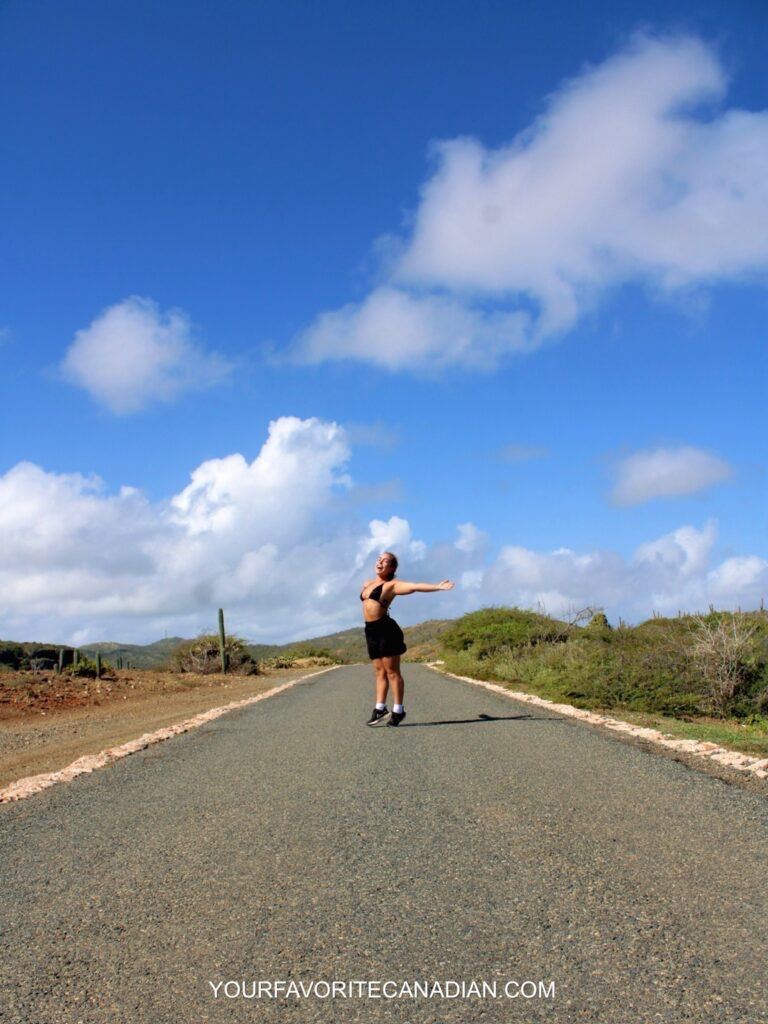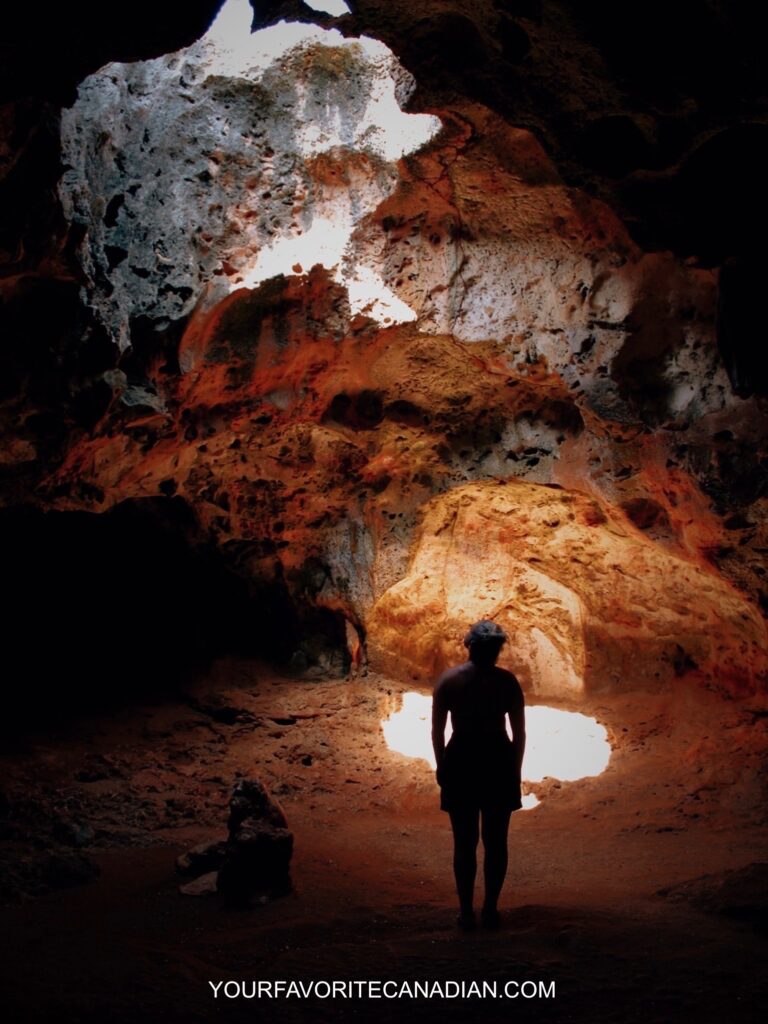There are so many incredible things to do at Arikok National Park, and during my visit, I experienced seven of the best activities the park has to offer. Each one provided a unique glimpse into Aruba’s natural beauty and rich history. While I didn’t get the chance to visit the Natural Pool (Conchi) due to lack of preparation and time, I’m including it here so you can plan ahead and make the most of your trip. Let’s dive into the top 8 activities you shouldn’t miss at Arikok National Park!
- Stop Along the Main Paved Road
- Dos Playa
- Boca Prins
- Fontein Cave
- Fish Pedicure
- Quadirikiri Cave
- Vader Piet
- Conchi (Natural Pool)
- Additional Information
1
Stop Along the Main Paved Road
As you drive along the main road through the park, take your time to stop and appreciate the breathtaking views. There are several viewpoints along the way where you can capture incredible photos of the rugged landscape and the distant ocean. Some notable spots include the panoramic views over Dos Playa and the rolling hills that lead to the coast. Make sure to bring your camera!

2
Dos Playa
Dos Playa consists of two adjacent coves, offering spectacular views of the rugged coastline and crashing waves. The beaches themselves aren’t ideal for swimming due to strong currents, but they are perfect for a quiet picnic or some scenic photography. It’s a serene spot to enjoy the untouched beauty of Aruba’s wild coastline, and you might even spot some wildlife like iguanas or seabirds.
3

Boca Prins
This beach is known for its stunning limestone cliffs, sandy dunes, and powerful waves. While it’s not the best place for swimming due to the strong currents, it’s visually striking and less crowded than other spots in the park. The natural landscape here feels remote and wild, making it a great spot for peaceful reflection or a stroll along the shoreline.
4
Fontein Cave
One of the most famous caves in Aruba, Fontein Cave is renowned for its ancient Arawak petroglyphs, created by the island’s indigenous people. The petroglyphs tell a fascinating story about the island’s history and its early inhabitants. The cave’s limestone formations are also impressive, creating a cool, shaded place to explore, especially on a hot day. Be sure to respect the ancient art by not touching the walls.

5
Fish Pedicure
While visiting Fontein Cave, ask a park guide to show you the nearby stream where tiny fish will give you a natural pedicure by nibbling away dead skin from your feet. It’s a quirky and fun experience that adds to the adventure. The water is clear and cool, making it a refreshing stop on your tour of the park.
6
Quadirikiri Cave
Known for its impressive limestone formations, Quadirikiri Cave is illuminated by natural light filtering through holes in the ceiling, creating a magical atmosphere. It also has historical significance, with local legends telling stories of its use as a refuge by early inhabitants. The cave extends for about 150 meters, and at the end of the tunnel, you’ll find bats roosting in the dark chambers.

7

Vader Piet
As you continue on the road, you’ll likely pass by Vader Piet, home to a wind farm on the park’s boundary. The sight of the towering wind turbines adds an interesting modern contrast to the natural surroundings. The wind farm is not a major tourist attraction, but it’s a unique feature that demonstrates Aruba’s commitment to renewable energy. It’s worth a stop for a quick photo of the turbines with the wild Aruban landscape in the background.
8
Conchi (Natural Pool)
This natural rock pool on Aruba’s northeast coast is only accessible by off-road vehicle or a long hike. It’s a popular spot for swimming and snorkeling, offering a serene escape within the rugged landscape. The pool is surrounded by volcanic rock, and the waves crashing over the rocks create a natural spectacle. If you’re up for an adventure, the best way to visit Conchi is by renting a 4×4 vehicle, as the terrain is challenging and requires off-road capability.
If hiking is more your style, you can take a challenging 1.5 to 2-hour hike from the park entrance. The hike offers stunning views of the coastline and takes you through some of the park’s more remote areas. However, be sure to bring plenty of water and sunscreen, as the hike can be demanding under the hot Aruban sun.
For renting a 4×4 for a day, you can expect to pay around 400 CAD for a four-seater or 360 CAD for a two-seater. This allows you the freedom to explore the park at your own pace.
Alternatively, if you’d prefer a guided tour, you can book one that includes the park entrance fee, a 4×4 vehicle, and other exciting activities.
Stay connected! Follow us on social media for exclusive content & updates on our travels.



On our website, you’ll find all the essential information and tips, while on our social media, you’ll get even more – including personal experiences, funny moments, stunning videos, and much more!
9
Additional Information
Walking distance: The park may seem vast, but many key attractions are relatively close to each other. The drive from the entrance to most sites is less than 30 minutes. For those who prefer walking, some of the areas are accessible by short hikes, so check the distance before setting out.
What to bring: Be prepared with plenty of water, snacks, sunscreen, and comfortable shoes, as the park can get quite hot. While there are some basic facilities, it’s best to pack everything you’ll need for a full day out, especially if you plan on hiking. Don’t forget your camera to capture the amazing scenery and wildlife!
How to get there: Arikok National Park is located in the eastern part of Aruba, about a 20-minute drive from Oranjestad. The park is best accessed by a rental car, and it’s highly recommended to use a 4×4 vehicle for certain areas. For those not comfortable driving, there are several guided tours available that include transportation and park fees.
Environmental Awareness: Arikok National Park is a protected area, so please respect the environment by staying on marked paths and not disturbing wildlife. Bring reusable water bottles and avoid single-use plastics. If possible, pick up any litter you see to help preserve the park’s natural beauty.
Safety Tips: While the views are stunning, be cautious when walking near cliffs or along rocky paths, as they can be slippery, especially near the ocean. Always check the tides before swimming at beaches like Dos Playa and Boca Prins, as the northern coast can have strong, unpredictable currents.
Don’t want to miss out on our latest articles? Be sure to subscribe to our website, and you’ll receive a notification every time we publish something new!
